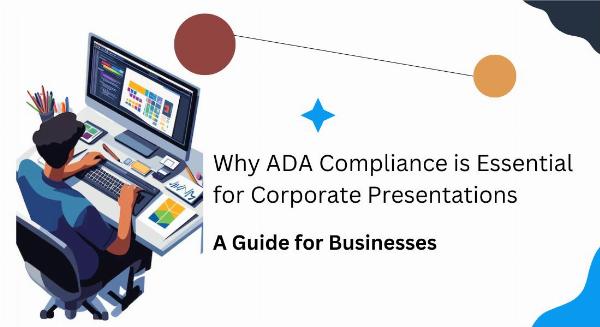Why ADA Compliance is Essential for Corporate Presentations: A Guide for Businesses

Strong 8k brings an ultra-HD IPTV experience to your living room and your pocket.
In today’s business environment, ensuring that your corporate presentations are accessible to all individuals is not just a matter of ethics—it’s also a legal obligation. The Americans with Disabilities Act (ADA) has set clear guidelines for accessibility, making it imperative for businesses to ensure that their presentations are ADA-compliant. This blog will explore why ADA compliance in presentations is critical for businesses, the benefits of adhering to these guidelines, and how you can make your corporate presentations fully accessible.
The Importance of ADA Compliance in Corporate Presentations
Ensuring ADA compliance in presentations is essential for businesses aiming to create inclusive environments. When crafting corporate presentations, it’s crucial to recognize the diversity of your audience, which may include individuals with disabilities. ADA compliance ensures that these individuals can engage with your content fully, regardless of their disabilities. Whether it’s providing alternative text for images, ensuring that text is readable by screen readers, or offering captions for video content, ADA compliance in presentations ensures that all participants can access the information.
Non-compliance can lead to legal repercussions, including fines and lawsuits, but the impact goes beyond just the legal aspect. By neglecting ADA guidelines, businesses risk alienating a significant portion of their audience, potentially leading to a loss of clients or customers. In contrast, ensuring ADA compliance in presentations showcases a company’s commitment to inclusivity and corporate social responsibility, enhancing its reputation and building trust with all stakeholders.
How ADA Compliance Enhances Corporate Presentations
Adhering to ADA guidelines does more than just meet legal requirements; it enhances the overall quality of corporate presentations. An ADA-compliant presentation is typically clearer, more organized, and easier to navigate, benefiting all participants, not just those with disabilities. For instance, using high-contrast color schemes and large, readable fonts makes content easier to see, while providing written descriptions for images helps all users understand the visual content. Moreover, an ADA-compliant corporate presentation is more likely to be engaging and effective, as it considers the needs of a diverse audience.
Additionally, ADA compliance in presentations can also serve as a benchmark for quality. When presentations are designed with accessibility in mind, it often leads to more thoughtful and purposeful content creation. This means that every aspect of the presentation, from layout to content delivery, is carefully considered to ensure that it can be understood and appreciated by everyone in the audience. This level of attention to detail not only meets ADA standards but also elevates the professionalism of the corporate presentation.
Implementing ADA Compliance in Corporate Presentations
Making your corporate presentations ADA-compliant involves several steps. First, consider the use of accessible templates and design tools that offer built-in ADA compliance features. These tools often include options for adding alternative text to images, ensuring proper contrast ratios, and enabling keyboard navigation. Second, incorporate captions for all video and audio content, and provide transcripts where possible. This ensures that individuals with hearing impairments can fully engage with the material.
Next, pay attention to the structure of your corporate presentation. Use headings and bullet points to break down information into manageable sections, making it easier for screen readers to navigate. Additionally, avoid overly complex animations and transitions, as these can be difficult for some users to process. Finally, test your presentation using accessibility checkers to ensure that it meets all ADA requirements. These tools can highlight any potential issues and suggest improvements, ensuring that your corporate presentation is accessible to everyone.
The Future of ADA Compliance in Corporate Presentations
As businesses continue to evolve, so too will the standards for ADA compliance in presentations. With the rise of virtual and hybrid events, the importance of making digital content accessible has become even more pronounced. Future developments may include more sophisticated tools for ensuring accessibility, as well as stricter enforcement of ADA guidelines. By staying ahead of these trends, businesses can ensure that their corporate presentations remain compliant and effective.
Moreover, the future of corporate presentations will likely involve a greater emphasis on inclusivity, with accessibility being a key component of this. Companies that prioritize ADA compliance in presentations will not only avoid legal issues but will also position themselves as leaders in corporate social responsibility. This proactive approach will be critical in fostering a more inclusive business environment, where all individuals can participate fully in presentations and other corporate communications.
Conclusion
In conclusion, ADA compliance in presentations is not just a legal requirement but a vital aspect of creating effective and inclusive corporate presentations. By adhering to ADA guidelines, businesses can ensure that their presentations are accessible to all, enhancing their reputation and avoiding potential legal issues. As the business landscape continues to evolve, staying ahead of ADA compliance trends will be essential for companies looking to lead in inclusivity and corporate responsibility. Ensuring ADA compliance in presentations today sets the foundation for a more inclusive and successful tomorrow.
Note: IndiBlogHub features both user-submitted and editorial content. We do not verify third-party contributions. Read our Disclaimer and Privacy Policyfor details.




